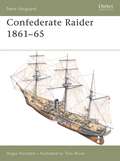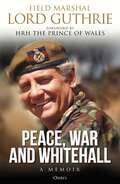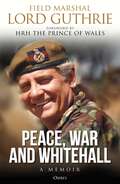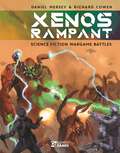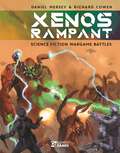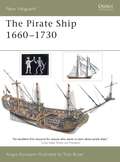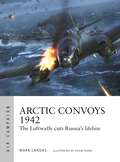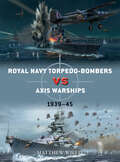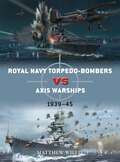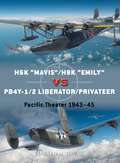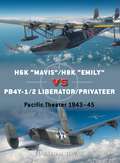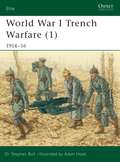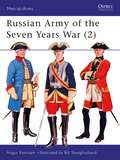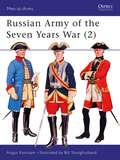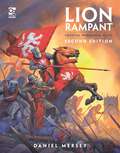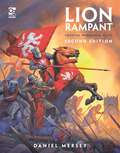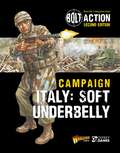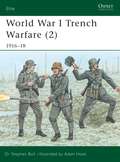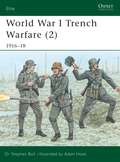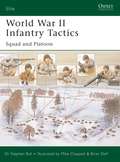- Table View
- List View
Confederate Raider 1861–65 (New Vanguard)
by Angus KonstamThe Confederate states adopted radical solutions to counter the naval superiority of their opponents. One of the more successful solutions they adopted was the use of commerce raiders. This book describes the reasons which forced the Confederates to resort to commerce raiding, and outlines the way in which these craft were converted or specially built to perform their role. It details not only the way these craft were operated and manned, but also their brutal attacks, daring escapes and climatic battles against the large numbers of Union warships forced to hunt them down.
Peace, War and Whitehall: A Memoir
by Charles Guthrie'Charles Guthrie has been one of Britain's foremost soldiers as well as a terrific personality throughout his remarkable life. It is great that he is now telling his own story.' - Sir Max HastingsField Marshal the Lord Guthrie commanded at every level in the British Army from platoon to army group, and was Britain's senior military commander at a time of great change. He oversaw the modernization of the armed forces following the Cold War years and led Britain's military involvement in operations in the Balkans and Sierra Leone. Charles Guthrie was commissioned into the British Army in 1959 at a time when Britain's influence was shrinking throughout the world, and Peace, War and Whitehall describes his operational experience with both the Welsh Guards and 22 SAS in Aden, Malaya, East Africa, Cyprus and Northern Ireland. As a senior officer he commanded the Welsh Guards during an operational tour of the Bandit Country of South Armagh at the height of the Troubles, before leading an armoured brigade in Germany in the midst of the Cold War, and eventually being appointed Commander-in-Chief of the British Army of the Rhine and Northern Army Group as the Cold War ended and the former Yugoslavia began to disintegrate into savage internecine warfare. Peace, War and Whitehall details Lord Guthrie's extraordinary career from a young platoon commander through to Chief of the Defence Staff.
Peace, War and Whitehall: A Memoir
by Charles Guthrie'Charles Guthrie has been one of Britain's foremost soldiers as well as a terrific personality throughout his remarkable life. It is great that he is now telling his own story.' - Sir Max HastingsField Marshal the Lord Guthrie commanded at every level in the British Army from platoon to army group, and was Britain's senior military commander at a time of great change. He oversaw the modernization of the armed forces following the Cold War years and led Britain's military involvement in operations in the Balkans and Sierra Leone. Charles Guthrie was commissioned into the British Army in 1959 at a time when Britain's influence was shrinking throughout the world, and Peace, War and Whitehall describes his operational experience with both the Welsh Guards and 22 SAS in Aden, Malaya, East Africa, Cyprus and Northern Ireland. As a senior officer he commanded the Welsh Guards during an operational tour of the Bandit Country of South Armagh at the height of the Troubles, before leading an armoured brigade in Germany in the midst of the Cold War, and eventually being appointed Commander-in-Chief of the British Army of the Rhine and Northern Army Group as the Cold War ended and the former Yugoslavia began to disintegrate into savage internecine warfare. Peace, War and Whitehall details Lord Guthrie's extraordinary career from a young platoon commander through to Chief of the Defence Staff.
Xenos Rampant: Science Fiction Wargame Battles
by Daniel Mersey Richard CowenScience Fiction wargame rules for large skirmishes, based on the popular Rampant system.Xenos Rampant is a setting agnostic, large skirmish, miniature wargame for fighting science fiction battles using 28mm figures. Developed from the popular Lion Rampant ruleset, the core mechanics featured within will be instantly recognisable to those familiar with the other Rampant systems, while still being accessible to new players. Xenos Rampant contains all the rules, army lists, and scenarios required to fight science fiction battles as well as a whole host of subgenres including: post-apocalyptic, weird war, near future. So, whatever your science fiction preference, the rules can cover it – just let your imagination run rampant.
Xenos Rampant: Science Fiction Wargame Battles
by Daniel Mersey Richard CowenScience Fiction wargame rules for large skirmishes, based on the popular Rampant system.Xenos Rampant is a setting agnostic, large skirmish, miniature wargame for fighting science fiction battles using 28mm figures. Developed from the popular Lion Rampant ruleset, the core mechanics featured within will be instantly recognisable to those familiar with the other Rampant systems, while still being accessible to new players. Xenos Rampant contains all the rules, army lists, and scenarios required to fight science fiction battles as well as a whole host of subgenres including: post-apocalyptic, weird war, near future. So, whatever your science fiction preference, the rules can cover it – just let your imagination run rampant.
The Pirate Ship 1660–1730 (New Vanguard)
by Angus KonstamThe deeds and personalities of famous pirates have received significant attention in recent years: however, no detailed depiction of their vessels has ever been produced. This title redresses the imbalance, conducting a detailed exploration of the wide variety of pirate vessels that sailed the high seas during the 'golden age' of piracy (1690–1730), from gun-bristling warships to smaller craft such as sloops, brigantines and early schooners. It incorporates the latest archaeological evidence to produce a fascinating account of these vessels, detailing their origins, development and tactical engagement. Packed with contemporary illustrations and superbly detailed colour artwork, the ships of the 'golden age' are brought vividly to life.
The Pirate Ship 1660–1730 (New Vanguard)
by Angus KonstamThe deeds and personalities of famous pirates have received significant attention in recent years: however, no detailed depiction of their vessels has ever been produced. This title redresses the imbalance, conducting a detailed exploration of the wide variety of pirate vessels that sailed the high seas during the 'golden age' of piracy (1690–1730), from gun-bristling warships to smaller craft such as sloops, brigantines and early schooners. It incorporates the latest archaeological evidence to produce a fascinating account of these vessels, detailing their origins, development and tactical engagement. Packed with contemporary illustrations and superbly detailed colour artwork, the ships of the 'golden age' are brought vividly to life.
Arctic Convoys 1942: The Luftwaffe cuts Russia's lifeline (Air Campaign)
by Mark LardasA new history of the most crucial few months of the Arctic Convoys, when Germany's air power forced the Allies to retreat to the cover of winter. Between spring and autumn 1942, Germany was winning the battle of the Arctic Convoys. Half of PQ-15 was sunk in May, PQ-17 was virtually obliterated in July, and in September 30 percent of PQ-18 was sunk. The Allies were forced to suspend the convoys until December, when the long Arctic nights would shield them.Mark Lardas argues that in 1942, it was Luftwaffe air power that made the difference. With convoys sailing in endless daylight, German strike aircraft now equipped and trained for torpedo attacks, and bases in northern Norway available, the Luftwaffe could wreak havoc. Three-quarters of the losses of PQ-18 were due to air attacks. But in November, the Luftwaffe was redeployed south to challenge the Allied landings in North Africa, and the advantage was lost. Despite that, the Allies never again sailed an Arctic convoy in the summer months.Fully illustrated with archive photos, striking new artwork, maps and diagrams, this is the remarkable history of the Luftwaffe's last strategic victory of World War II.
Arctic Convoys 1942: The Luftwaffe cuts Russia's lifeline (Air Campaign)
by Mark LardasA new history of the most crucial few months of the Arctic Convoys, when Germany's air power forced the Allies to retreat to the cover of winter. Between spring and autumn 1942, Germany was winning the battle of the Arctic Convoys. Half of PQ-15 was sunk in May, PQ-17 was virtually obliterated in July, and in September 30 percent of PQ-18 was sunk. The Allies were forced to suspend the convoys until December, when the long Arctic nights would shield them.Mark Lardas argues that in 1942, it was Luftwaffe air power that made the difference. With convoys sailing in endless daylight, German strike aircraft now equipped and trained for torpedo attacks, and bases in northern Norway available, the Luftwaffe could wreak havoc. Three-quarters of the losses of PQ-18 were due to air attacks. But in November, the Luftwaffe was redeployed south to challenge the Allied landings in North Africa, and the advantage was lost. Despite that, the Allies never again sailed an Arctic convoy in the summer months.Fully illustrated with archive photos, striking new artwork, maps and diagrams, this is the remarkable history of the Luftwaffe's last strategic victory of World War II.
Royal Navy torpedo-bombers vs Axis warships: 1939–45 (Duel)
by Matthew WillisDrawing on rare, historical photography and specially commissioned artwork, Matthew Willis explores the heroic feats of the few Royal Navy's obsolescent biplanes that stood between the state-of-the-art Axis warships and their objectives.Focusing on the technical specifications of both opponents, using original records, and detailed armament and cockpit views, this book explores the key attributes and drawbacks of the disadvantaged Royal Navy torpedo-bombers against the mighty Regia Marina and Kriegsmarine destroyers and raiders, covering a wide range of sea battles, from the more famous attacks such as the strike on the Bismarck, the tragic events of the Channel Dash or the clash with the Italian battle fleet at Taranto, to less covered sea battles such as the Battle of Matapan.Despite their powerful weaponry and heavy armour protection, the Axis warships proved vulnerable to a skillfully and audaciously flown torpedo-bomber, thanks to innovative commanders exploiting every possible advantage. Including rare personal recollections from the airmen who flew the torpedo-bombers and historical accounts from the Axis warship crews, this book describes each and every facet of this dramatic duel.
Royal Navy torpedo-bombers vs Axis warships: 1939–45 (Duel)
by Matthew WillisDrawing on rare, historical photography and specially commissioned artwork, Matthew Willis explores the heroic feats of the few Royal Navy's obsolescent biplanes that stood between the state-of-the-art Axis warships and their objectives.Focusing on the technical specifications of both opponents, using original records, and detailed armament and cockpit views, this book explores the key attributes and drawbacks of the disadvantaged Royal Navy torpedo-bombers against the mighty Regia Marina and Kriegsmarine destroyers and raiders, covering a wide range of sea battles, from the more famous attacks such as the strike on the Bismarck, the tragic events of the Channel Dash or the clash with the Italian battle fleet at Taranto, to less covered sea battles such as the Battle of Matapan.Despite their powerful weaponry and heavy armour protection, the Axis warships proved vulnerable to a skillfully and audaciously flown torpedo-bomber, thanks to innovative commanders exploiting every possible advantage. Including rare personal recollections from the airmen who flew the torpedo-bombers and historical accounts from the Axis warship crews, this book describes each and every facet of this dramatic duel.
H6K “Mavis”/H8K “Emily” vs PB4Y-1/2 Liberator/Privateer: Pacific Theater 1943–45 (Duel)
by Edward M. YoungAn illustrated exploration of the dramatic aerial combats between the US Navy's long-range bomber and Japanese flying boats in the Pacific War.Edward Young explores these rarely written about combats, examining the aggressive and strategic tactics deployed by both US Navy and Imperial Japanese Navy Air Force and analyzing the technical improvements installed throughout the war.The PB4Y-1/2 Liberator/Privateer was the US Navy's first four-engined, land-based bomber, adapted and allocated to fight the U-boat menace in the Atlantic and protect the vast reaches of the Pacific Ocean. The long range, speed, armament and bomb load of the PB4Y-1 enabled the US Navy's Pacific squadrons to adopt more aggressive tactics. The PB4Y-1, and its follow-on PB4Y-2, engaged in dangerous bombing missions against Japanese installations, shipping strikes, and air combat. On the other side, with its doctrine of making the first strike against an enemy fleet, the Imperial Japanese Navy recognized the vital importance of maritime reconnaissance, relying on carrier-based reconnaissance aircraft, ship-borne floatplanes and, for long-range maritime patrol, flying boats. The Japanese would continue to develop their aircraft throughout the war, resulting, among others, in the H6K 'Mavis' and the H8K2 'Emily', which despite never achieving a victory, was regarded by the Allied pilots as the most difficult Japanese aircraft to destroy. Enriched with specially commissioned artwork, including armament and cockpit views, battlescenes and technical diagrams, this title analyses technical specifications in detail. By including first-hand accounts, aviation expert Edward Young provides a detailed account of these one-sided yet dramatic and aggressive combats.
H6K “Mavis”/H8K “Emily” vs PB4Y-1/2 Liberator/Privateer: Pacific Theater 1943–45 (Duel)
by Edward M. YoungAn illustrated exploration of the dramatic aerial combats between the US Navy's long-range bomber and Japanese flying boats in the Pacific War.Edward Young explores these rarely written about combats, examining the aggressive and strategic tactics deployed by both US Navy and Imperial Japanese Navy Air Force and analyzing the technical improvements installed throughout the war.The PB4Y-1/2 Liberator/Privateer was the US Navy's first four-engined, land-based bomber, adapted and allocated to fight the U-boat menace in the Atlantic and protect the vast reaches of the Pacific Ocean. The long range, speed, armament and bomb load of the PB4Y-1 enabled the US Navy's Pacific squadrons to adopt more aggressive tactics. The PB4Y-1, and its follow-on PB4Y-2, engaged in dangerous bombing missions against Japanese installations, shipping strikes, and air combat. On the other side, with its doctrine of making the first strike against an enemy fleet, the Imperial Japanese Navy recognized the vital importance of maritime reconnaissance, relying on carrier-based reconnaissance aircraft, ship-borne floatplanes and, for long-range maritime patrol, flying boats. The Japanese would continue to develop their aircraft throughout the war, resulting, among others, in the H6K 'Mavis' and the H8K2 'Emily', which despite never achieving a victory, was regarded by the Allied pilots as the most difficult Japanese aircraft to destroy. Enriched with specially commissioned artwork, including armament and cockpit views, battlescenes and technical diagrams, this title analyses technical specifications in detail. By including first-hand accounts, aviation expert Edward Young provides a detailed account of these one-sided yet dramatic and aggressive combats.
World War I Trench Warfare: 1914–16 (Elite)
by Stephen BullThe regular armies which marched off to war in 1914 were composed of massed riflemen, screened by cavalry and supported by artillery; their leaders expected a quick and decisive outcome, achieved by sweeping manoeuvre, bold leadership and skill at arms. Eighteen months later the whole nature of field armies and their tactics had changed utterly. In sophisticated trench systems forming a battlefield a few miles wide and 400 miles long, conscript armies sheltered from massive long-range bombardment, wielding new weapons according to new tactical doctrines. This first of two richly illustrated studies explains in detail the specifics of that extraordinary transformation, complete with ten full colour plates of uniforms and equipment.
World War I Trench Warfare: 1914–16 (Elite)
by Stephen BullThe regular armies which marched off to war in 1914 were composed of massed riflemen, screened by cavalry and supported by artillery; their leaders expected a quick and decisive outcome, achieved by sweeping manoeuvre, bold leadership and skill at arms. Eighteen months later the whole nature of field armies and their tactics had changed utterly. In sophisticated trench systems forming a battlefield a few miles wide and 400 miles long, conscript armies sheltered from massive long-range bombardment, wielding new weapons according to new tactical doctrines. This first of two richly illustrated studies explains in detail the specifics of that extraordinary transformation, complete with ten full colour plates of uniforms and equipment.
Russian Army of the Seven Years War (Men-at-Arms)
by Angus KonstamThis second volume (see MAA 297) by Angus Konstam on the Russian Army of the Seven Years War concentrates on the cavalry, both the regular troops and irregular forces, considering their composition, nature and effectiveness. It also outlines the state of the Russian train of artillery, which was seen as the premier branch of the army and dominated Russian military doctrine throughout the 18th century. As a result of reforms to the, the Russians entered the war with Prussia somewhat wrong footed. The ability of the army to recover from this in the crucible of war is a major part of this story.
Russian Army of the Seven Years War (Men-at-Arms)
by Angus KonstamThis second volume (see MAA 297) by Angus Konstam on the Russian Army of the Seven Years War concentrates on the cavalry, both the regular troops and irregular forces, considering their composition, nature and effectiveness. It also outlines the state of the Russian train of artillery, which was seen as the premier branch of the army and dominated Russian military doctrine throughout the 18th century. As a result of reforms to the, the Russians entered the war with Prussia somewhat wrong footed. The ability of the army to recover from this in the crucible of war is a major part of this story.
Lion Rampant: Medieval Wargaming Rules
by Daniel MerseyAn expanded edition of the Origins Award-nominated Lion Rampant, featuring new rules, scenarios, and sample armies.Take to the battlefield as Richard the Lionheart, Joan of Arc or William Wallace – or forge your own legend – with Lion Rampant: Second Edition. From the Dark Ages to the Hundred Years' War, raids, skirmishes, and clashes between small retinues were a crucial part of warfare, and these dramatic small-scale battles are at the heart of this easy-to-learn but tactically rewarding wargame. Lion Rampant: Second Edition is a new, updated version of the hit Osprey Wargames series title, and retains the core gameplay while also incorporating a wealth of new rules and updates from several years' worth of player feedback and development. Whether they are looking to recreate historical encounters or tell their own stories, the varied scenarios, unit types, and sample retinue lists found in this volume provide everything players need to face each other in quick, exciting, and, above all, fun tabletop battles.
Lion Rampant: Medieval Wargaming Rules
by Daniel MerseyAn expanded edition of the Origins Award-nominated Lion Rampant, featuring new rules, scenarios, and sample armies.Take to the battlefield as Richard the Lionheart, Joan of Arc or William Wallace – or forge your own legend – with Lion Rampant: Second Edition. From the Dark Ages to the Hundred Years' War, raids, skirmishes, and clashes between small retinues were a crucial part of warfare, and these dramatic small-scale battles are at the heart of this easy-to-learn but tactically rewarding wargame. Lion Rampant: Second Edition is a new, updated version of the hit Osprey Wargames series title, and retains the core gameplay while also incorporating a wealth of new rules and updates from several years' worth of player feedback and development. Whether they are looking to recreate historical encounters or tell their own stories, the varied scenarios, unit types, and sample retinue lists found in this volume provide everything players need to face each other in quick, exciting, and, above all, fun tabletop battles.
Bolt Action: Campaign: Italy: Soft Underbelly (Bolt Action)
by Warlord GamesWith the Axis Powers ejected from North Africa, the Western Allies look to take the fight across the Mediterranean and into Mussolini's Italy. This supplement for Bolt Action focuses on Operation Husky, the airborne and naval invasion of Sicily, the hard-fought battles in the villages and rugged mountain passes of that island, and the advance up the Italian Peninsula towards Rome. With a host of scenarios, new units, special rules, and Theatre Selectors this book contains everything players need to refight these important battles in defence of the Regno d'Italia or to strike at the underbelly of Axis-controlled Europe.
Bolt Action: Campaign: Italy: Soft Underbelly (Bolt Action)
by Warlord GamesWith the Axis Powers ejected from North Africa, the Western Allies look to take the fight across the Mediterranean and into Mussolini's Italy. This supplement for Bolt Action focuses on Operation Husky, the airborne and naval invasion of Sicily, the hard-fought battles in the villages and rugged mountain passes of that island, and the advance up the Italian Peninsula towards Rome. With a host of scenarios, new units, special rules, and Theatre Selectors this book contains everything players need to refight these important battles in defence of the Regno d'Italia or to strike at the underbelly of Axis-controlled Europe.
World War I Trench Warfare: 1916–18 (Elite)
by Stephen BullThe Allied attempt to break the stalemate of trench warfare by the 'big pushes' of 1916 led to massively costly battles of attrition. The Germans responded by developing schemes of defence in depth anchored on concrete bunkers; the Allies, by sophisticated artillery tactics in support of infantry assaults, and by the introduction of the tank - at first an accident-prone novelty, but later a front-breaking weapon. On both sides the small, self-reliant, opportunistic infantry unit, with its own specialist weapons, became the basic tool of attack. This second of a fascinating two-part study of the birth of 20th century tactics is illustrated in colour and includes rare photographs.
World War I Trench Warfare: 1916–18 (Elite)
by Stephen BullThe Allied attempt to break the stalemate of trench warfare by the 'big pushes' of 1916 led to massively costly battles of attrition. The Germans responded by developing schemes of defence in depth anchored on concrete bunkers; the Allies, by sophisticated artillery tactics in support of infantry assaults, and by the introduction of the tank - at first an accident-prone novelty, but later a front-breaking weapon. On both sides the small, self-reliant, opportunistic infantry unit, with its own specialist weapons, became the basic tool of attack. This second of a fascinating two-part study of the birth of 20th century tactics is illustrated in colour and includes rare photographs.
World War II Infantry Tactics: Squad and Platoon (Elite)
by Stephen BullDespite all technological advances, final mastery of any battlefield depends upon the tight-knit group of footsoldiers trained to manoeuvre, shoot and dig in. This first of a two-part study examines the methods by which the Western infantry of World War II - the German, British and US armies - actually brought their firepower to bear. Drawing upon period training manuals for the evolving theory, and on personal memoirs for the individual practice, this first book covers the organization and tactics of the squad of ten or a dozen men, and the platoon of three or four squads. The text is illustrated with contemporary photographs and diagrams, and with colour plates bringing to life the movement of soldiers on the battlefield.
World War II Infantry Tactics: Squad and Platoon (Elite)
by Stephen BullDespite all technological advances, final mastery of any battlefield depends upon the tight-knit group of footsoldiers trained to manoeuvre, shoot and dig in. This first of a two-part study examines the methods by which the Western infantry of World War II - the German, British and US armies - actually brought their firepower to bear. Drawing upon period training manuals for the evolving theory, and on personal memoirs for the individual practice, this first book covers the organization and tactics of the squad of ten or a dozen men, and the platoon of three or four squads. The text is illustrated with contemporary photographs and diagrams, and with colour plates bringing to life the movement of soldiers on the battlefield.
